Aftermath of World War I facts for kids
| Part of the interwar period | |

William Orpen's The Signing of Peace in the Hall of Mirrors: the signing of the Treaty of Versailles in the Hall of Mirrors at the Palace of Versailles in 1919
|
|
| Date | 11 November 1918 – 1 September 1939 (20 years, 9 months and 3 weeks) |
|---|---|
| Outcome | Political and social changes such as:
|
The aftermath of World War I refers to the huge changes that happened around the world after the war ended. These changes affected culture, money, and how people lived in Europe, Asia, Africa, and even other places. Four large empires fell apart because of the war. Old countries disappeared, and new ones were created. Borders were redrawn on maps. New international groups were formed, and many new ideas took hold in people's minds.
The war also changed politics in most of the main countries involved. Many became democracies, where people could vote. For the first time, almost everyone could vote, like in Germany, Great Britain, and Turkey.
| Top - 0-9 A B C D E F G H I J K L M N O P Q R S T U V W X Y Z |
Germany's Blockade: A Tough Time
After the fighting stopped on November 11, 1918, the Allied powers kept their naval blockade on Germany. This blockade had been in place during the war. Germany relied on imports for food and other goods. Because of the blockade, it's thought that about half a million German civilians died from lack of food.
Some historians believe that a quarter of a million more people died in the eight months after the war ended. This was due to the continued blockade. The Allies said they would allow food if Germany provided the ships. But Germany struggled to do this.
Some historians also say that the Allies offered food and medicine after the armistice. They claim Germany refused to use its ships to carry supplies. They also state that Allied ships brought food to Germany before the Treaty of Versailles was signed. Despite this, the blockade continued in some form for eight months. This caused many more deaths among German civilians.
The Paris Peace Conference: Making Peace
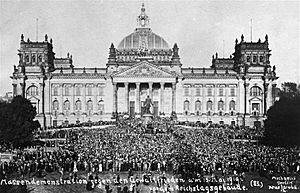
After the Paris Peace Conference in 1919, the Treaty of Versailles was signed on June 28, 1919. This treaty officially ended the war between Germany and the Allied powers like France, Italy, and Britain. Other treaties ended the war for the United States and other Central Powers.
The Treaty of Versailles had 440 rules. It made Germany accept blame for starting the war and causing all the damage. Germany also had to pay a lot of money to the winning countries. The treaty also greatly limited Germany's military. Germany could only have 100,000 soldiers. It was not allowed to have tanks, large warships, armored vehicles, or submarines.
The Flu Epidemic: A Global Sickness

- War of Independence in Estonia and Latvia
- White Army of General Yudenich
- North Russia intervention
- White Army of Kolchak's in Siberia
- General Denikin's White Army
- General Petlura's Ukrainian directorate
- Polish–Soviet War
- Silesia tension between the Poles and Germans.
- Romanian occupation of Hungary
- Gabriele D'Annunzio's seizes Fiume, creates the Italian Regency of Carnaro
- In Albania fighting is going on
- Turkish War of Independence
Historians still discuss how the 1918 flu pandemic affected the war's outcome. It's thought that the Central Powers might have been hit by the flu first. This could have weakened them during the war. The Allies, however, felt the worst of the flu after the war ended.
Governments on both sides tried to hide how bad the flu was. They didn't want people to panic. Because Spain was a neutral country, its news could report freely on the flu. This made people think the flu started there, leading to the name "Spanish flu."
Scientists later found that the flu likely started in a troop camp in France. It's believed to have come from a virus in birds that changed in pigs. About 50 million people worldwide died from this flu.
New Countries and Identities Emerge
After 123 years, Poland became an independent country again. The Kingdom of Serbia helped form a new country called the Kingdom of Serbs, Croats and Slovenes, later known as Yugoslavia. Czechoslovakia was also created, combining parts of the old Austrian and Hungarian empires. Romania united all Romanian-speaking people into one larger state.
Russia became the Soviet Union and lost several areas. Finland, Estonia, Lithuania, and Latvia all became independent nations. The Ottoman Empire was replaced by Turkey. Many of its former lands became territories managed by Britain or France.
New National Pride in the British Empire
In the British Empire, the war sparked new feelings of national identity. For Australia and New Zealand, the Battle of Gallipoli was a defining moment. It was the first major war where these new countries fought. Australian troops fought as Australians, not just as subjects of the British Crown. This helped them develop their own national identities. Anzac Day celebrates this important moment for Australia and New Zealand.
Canadians also felt a new sense of pride after the Battle of Vimy Ridge. Canadian divisions fought together as one group for the first time and succeeded where others had failed. This made them respected internationally. Canada, Australia, and New Zealand entered the war as parts of the British Empire. But they gained more independence afterward. They even signed the Treaty of Versailles as individual nations.
Changes in the Middle East
The war also led to big changes in the Middle East. The British government supported creating a Jewish homeland in Palestine. This was stated in the Balfour Declaration of 1917.
The fall of the Ottoman Empire after World War I created new problems in the Middle East. Power vacuums appeared, and different groups claimed land. The new borders drawn by the winning countries often didn't consider the local people. These borders still cause problems today, affecting national identity and leading to conflicts over land and resources.
Romanian prisoners of war formed groups like the Romanian Volunteer Corps in Russia and fought in different armies. They supported the White movement against the Red Army in the Russian Civil War. They also fought against Austria-Hungary and in the Hungarian-Romanian War.
In 1918, three new states formed in the South Caucasus: Armenia, Azerbaijan, and Georgia. They declared independence from the Russian Empire. These countries faced threats from the Ottoman Empire. They tried to unite briefly but then sought protection from Germany or made deals with the Ottomans. Armenia fought hard to defend itself.
Greece fought against Turkish nationalists. This war led to a large exchange of people between the two countries. Many Greeks died during this time.
Political Upheavals: A Time of Change
Revolutions Across Europe
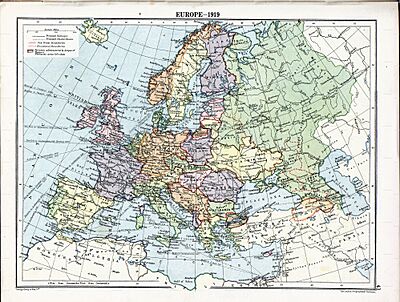
After World War I, many European countries saw big political changes. There was a wave of communist revolutions, especially in Germany and Hungary. The most important event was the Russian Revolution of 1917.
Austria-Hungary: An Empire Falls Apart
As the war turned against the Central Powers, people in Austria-Hungary lost faith in their government. Even before the war ended, different groups declared independence. The central government stopped working in many areas. This left regions without a government. People also faced food shortages and were tired of the war.
Many new political groups tried to form governments. These groups included nationalists, social democrats, and communists. Other existing countries, like Romania, took control of areas they believed were theirs. These actions created new, unofficial governments. This made things difficult for diplomats trying to make peace.
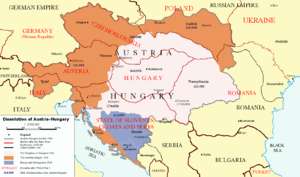
The Western powers were supposed to occupy the old empire. But they didn't have enough soldiers. They had to deal with local leaders who had their own plans. At the peace conference in Paris, diplomats had to balance many things. They had to consider the demands of different nationalist groups. They also had to think about the Western Allies' own goals.
For example, the idea of "self-determination" meant Germans should decide their own future. But France worried that a larger Germany would be a threat. Also, groups like the Czechs and Slovenians wanted some German-speaking lands.
The result was treaties that made many compromises. They upset some allies and created a completely new order in the region. Many hoped these new countries would bring peace. But this hope was too optimistic.
Here are some of the territorial changes after World War I:
- The Republic of German Austria and the Hungarian Democratic Republic were formed. The old ruling family, the Habsburgs, were exiled.
- After 1920, the new borders of Hungary were much smaller. It lost about two-thirds of its land.
- Bohemia, Moravia, and parts of Hungary formed the new Czechoslovakia.
- Parts of the old empire, like Galicia, went to Poland.
- Southern Tyrol and Trieste went to Italy.
- Bosnia and Herzegovina, Croatia-Slavonia, and other regions joined Serbia to form the Kingdom of the Serbs, Croats and Slovenes, later called Yugoslavia.
- Transylvania and other regions became part of Romania.
- The Austro-Hungarian area in Tianjin, China, was given to the Republic of China.
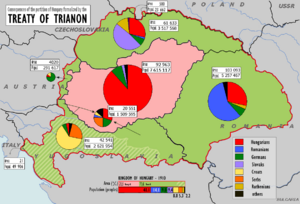
These changes were recognized by the treaties, but they were already happening. The Treaty of Saint-Germain and the Treaty of Trianon further explained them.
The 1919 treaties tried to protect the rights of ethnic minorities. But there was no way to enforce these rules. The new countries in Eastern Europe had many different ethnic groups. Millions of Germans found themselves living as minorities in new countries. Over two million Hungarians lived outside Hungary in Czechoslovakia, Romania, and Yugoslavia. Many minorities faced difficulties because new governments wanted to define their country's national identity, often at the expense of other groups.
The war caused economic problems. The end of the Austro-Hungarian customs union made things even harder. Many new states started as democracies. But most, except Czechoslovakia, soon became authoritarian. They often argued among themselves and were too weak to compete. Later, when Germany rebuilt its military, these countries couldn't resist. They fell under German control even more than they had under Austria-Hungary.
Germany: A New Republic and Hard Times
In Germany, a socialist revolution happened. This led to the Kaiser Wilhelm II stepping down. It also led to the creation of the Weimar Republic.
On June 28, 1919, Germany was forced to sign the Treaty of Versailles. The Allies threatened to continue fighting if Germany refused. Germany saw this treaty as a huge insult. They felt it unfairly blamed them for the entire war. The treaty was meant to make Germany pay for damages. But the idea of blame became a big political issue in Germany. Many nationalists never accepted it. The German government even spread propaganda to support this idea.
Germany had to pay 132 billion gold marks (about $31.5 billion) in reparations. To pay for foreign money, the new German republic printed a lot of money. This led to hyperinflation between 1921 and 1923. Money became almost worthless. In 1923, French and Belgian troops occupied the Ruhr region until 1925 to force Germany to pay.
The treaty also made Germany reduce its army to 100,000 men. They had to destroy their tanks, air force, and submarines.
Germany lost some territory to Denmark, Czechoslovakia, and Belgium. A larger part went to France, and the biggest portion helped create a new Poland. Germany's colonies overseas were divided among Allied countries. But the loss of land to Poland, including the city of Danzig, caused the most anger. This anger was later used by Adolf Hitler and the Nazis to gain political support.
Ottoman Empire: The Birth of Turkey
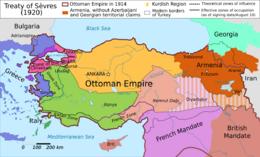
After the war, the Allies occupied Constantinople (now Istanbul). The Ottoman government fell apart. The Treaty of Sèvres was signed in 1920. It was meant to fix the damage caused by the Ottomans during the war. But the Sultan never officially approved it.
When Greece occupied Smyrna in 1919, it sparked a strong Turkish nationalist movement. Mustafa Kemal Atatürk, a successful Ottoman commander, led Turkish revolutionaries. He rejected the Treaty of Sèvres. He left Istanbul to organize the remaining Ottoman forces to fight against the treaty's terms. On the eastern front, Turkey gained territory from Armenia and Russia.
On the western front, the Turkish nationalist forces grew stronger. The Kingdom of Greece, with British support, invaded deep into Anatolia. They wanted to defeat the revolutionaries. But the Greek army was defeated. They were forced to retreat, leading to the burning of Smyrna.
With the nationalists in control, the army marched to reclaim Istanbul. This led to a crisis that forced the British Prime Minister to resign. After Turkey gained control of Anatolia and Istanbul, the Treaty of Sèvres was replaced by the Treaty of Lausanne in 1923. This treaty officially ended all fighting and created the modern Turkish Republic. Turkey was the only power from World War I to overturn its defeat terms and negotiate as an equal.
The Lausanne Treaty recognized new territories managed by the League of Nations in the Middle East. It also gave Britain control over Cyprus. Parts of the Ottoman Empire in the Arabian Peninsula became parts of what are now Saudi Arabia and Yemen. The fall of the Ottoman Empire was a key event in shaping the modern Middle East. It also led to new conflicts in the region.
Russian Empire: Revolution and New Nations
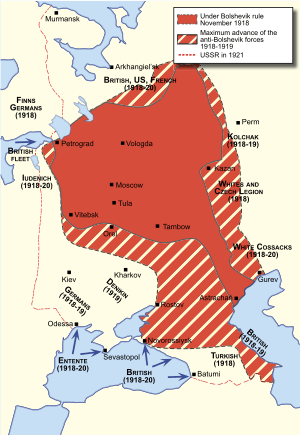
The Soviet Union gained from Germany's loss. One of the first terms of the armistice was to cancel the Treaty of Brest-Litovsk. At the time of the armistice, Russia was in a civil war. This war killed over seven million people and destroyed large parts of the country. The nation suffered greatly.
Lithuania, Latvia, and Estonia gained independence. However, the Soviet Union occupied them again in 1940.
Finland gained lasting independence. But it had to fight the Soviet Union several times to protect its borders.
Armenia, Georgia, and Azerbaijan became independent states in the Caucasus region. However, after Turkish and Russian invasions, these three countries became Soviet Republics in 1920. They were absorbed into the Soviet Union in 1922.
Romania gained Bessarabia from Russia.
The Russian area in Tianjin, China, was taken by the Chinese government in 1920. In 1924, the Soviet Union gave up its claims to the area.
United Kingdom: Economic Struggles and Growing Independence
In the United Kingdom of Great Britain and Ireland, paying for the war was very expensive. Britain went from being the world's largest investor to one of its biggest debtors. Interest payments made up about 40% of all government spending. Prices more than doubled between 1914 and 1920.
British private investments abroad were sold. But new investments also happened during the war. The total financial loss was not huge. The biggest material loss was 40% of the British Merchant Navy, sunk by German U-boats. Most of these ships were replaced quickly after the war. Some historians argue that the war didn't cripple Britain economically, but it did affect them psychologically.
Less clear changes included the growing confidence of Commonwealth nations. Battles like Gallipoli for Australia and New Zealand, and Vimy Ridge for Canada, led to more national pride. These nations became less willing to be fully controlled by Britain. This led to them gaining more diplomatic independence in the 1920s. These battles were often shown in propaganda as symbols of their power. Countries like British India and Nigeria also became more assertive because they helped in the war. Their people became more aware of their own strength and Britain's weaknesses.

In Ireland, the delay of a law to give Ireland more self-rule caused problems. The British government's harsh response to the 1916 Easter Rising and its attempt to force Irish men into the army also increased support for independence. This led to the Irish War of Independence in 1919. The creation of the Irish Free State meant Britain lost a large part of Ireland. However, the new Irish Free State remained a part of the British Empire.
World War I also changed British politics. The Labour Party grew stronger. The Liberal Party split and declined. The war led to the establishment of universal suffrage, meaning more people could vote. This helped the Labour Party grow.
China: A New National Feeling
The Republic of China was one of the Allies. During the war, they sent thousands of workers to France. At the Paris Peace Conference in 1919, China asked for an end to Western control in its country. But their request was denied. China wanted its territory of Jiaozhou Bay, which Germany controlled, back. Instead, the Western Allies gave all of Germany's former rights in China to Japan. Because of this, China did not sign the Treaty of Versailles. It signed a separate peace treaty with Germany in 1921.
The areas in Tianjin, China, that were controlled by Austria-Hungary and Germany were given to the Chinese government. China also took over the Russian area in 1920.
The Allies giving Chinese territory to Japan led to the May Fourth Movement in China. This was a social and political movement that greatly influenced China's history. It is often seen as the birth of Chinese nationalism. Both the Kuomintang and Chinese Communist Party see this movement as very important.
France: Reclaiming Land and Changing Society
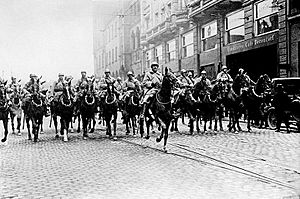
Alsace–Lorraine was returned to France. This region had been given to Germany in 1871 after the Franco-Prussian War. At the 1919 Peace Conference, French Prime Minister Georges Clemenceau wanted to make sure Germany couldn't seek revenge. The Allied commander, Marshal Ferdinand Foch, wanted the Rhine river to be the border between France and Germany. He believed Germany would always be a threat. When he heard the terms of the Treaty of Versailles, which left Germany mostly intact, he said, "This is not Peace. It is an Armistice for twenty years."
The damage to French land was supposed to be paid for by Germany through reparations. This need for money shaped France's foreign policy in the 1920s. It led to France occupying the Ruhr region in 1923 to force Germany to pay. However, Germany couldn't pay and got help from the United States.
French colonial troops also played a big part in the war. They made up about 10% of France's total troops. When these soldiers returned home, they were still treated as second-class citizens. Many became leaders of groups fighting for independence in their home countries.
The war also changed France's economy. The government took more control to shift into a "war economy." This was a break from traditional economic ideas.
Women in France: New Roles and Debates
The war changed society greatly. Many old ideas and beliefs were shattered. When men returned home, the world was very different. People had to rebuild their lives and beliefs. Before the war, many thought it would be quick. But new technology made it long and brutal. France suffered huge losses, and life for its citizens changed forever.
Many people saw the cultural changes and blamed the war. They felt it took away society's innocent view of things. The war also greatly changed gender roles.
During the war, women took over many jobs that men usually did, especially in factories. This gave women a new sense of freedom. Many women didn't want to go back to their old roles of just staying home. When the war ended, older generations and men wanted women to return to their previous roles.
This change was shocking because gender roles were very strict at the time. While changes had been happening slowly since the Industrial Revolution, the war caused a very fast and drastic shift. France lost many lives in World War I. This meant many jobs couldn't be refilled by men after the war. So, women continued to work.
Discussions about gender identity and roles became a main way to talk about the war. People struggled to understand the new reality. There were mixed reactions to the new way of life. Some embraced the changes, while others strongly rejected them. Some tried to find a middle ground between old and new ways.
Discussions about women after the war often put them into three groups: the "modern woman," the "mother," and the "single woman." These groups described women by their roles, jobs, actions, or beliefs. The "mother" represented the traditional woman who stayed home. The "modern woman" was the fast-paced woman working men's jobs. The "single woman" was a middle ground. This group represented women who might never marry because there weren't enough men after the war.
Fashion also sparked debate. During the war, fabric was rationed. Women wore shorter dresses or pants. Many continued this style after the war. This big change in clothing norms led to some "modern women" being criticized.
Men returning from the war were often traumatized. They wanted to come back to a home that hadn't changed much, to feel normal again. When they found a changed home, they struggled to accept it. The clear gender roles they knew were gone. It was hard for these men to accept the new ways, especially how women behaved.
Italy: A "Mutilated Victory"
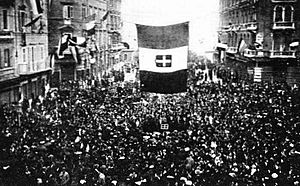
In 1882, Italy joined Germany and Austria-Hungary to form the Triple Alliance. But Italy's alliance with Austria was weak. Italy wanted to gain Trentino and Trieste, which were parts of Austria-Hungary with Italian populations.
During World War I, Italy joined the Allies instead of Germany and Austria. This was because their alliance was only for defense, and the Central Powers started the attack. In a secret agreement, Britain promised Italy several territories if it joined the Allies. These included Trentino, Trieste, and parts of the Dalmatian coast.
After the Allied victory, Italy's leaders went to the Paris Peace Conference. They wanted the promised lands and more. They especially wanted Fiume, which they believed was Italian.
However, the Allies had made conflicting promises to other nations. Italy was only offered Trentino, the port of Zara, and a few small German colonies. Other territories were promised to other countries. The Allies worried about Italy's desire for more land. The US President, Woodrow Wilson, supported Yugoslavia's claims over Dalmatia. Italy's leaders left the conference angry. This allowed Britain and France to divide former Ottoman and German territories in Africa among themselves.
In Italy, there was great unhappiness. Many felt Italy had fought a meaningless war without gaining enough. This idea of a "mutilated victory" became popular. On September 12, 1919, a nationalist poet, Gabriele d'Annunzio, led about 2,600 troops to take over the city of Fiume. This idea of a "mutilated victory" became an important part of Italian fascist propaganda.
Japan: Gains and Disappointment
Because of a treaty with Great Britain, Japan was one of the Allies. Japanese forces attacked Germany's territories in China. They also seized several German islands in the western Pacific.
At the Paris Peace Conference in 1919, Japan gained all of Germany's former rights in China's Shandong Province. This included control of Jiaozhou Bay and trade rights. Japan also gained control over German Pacific islands. Japan was given a permanent seat on the Council of the League of Nations. However, the Western powers refused Japan's request to include a "racial equality" clause in the Treaty of Versailles. Shandong later returned to Chinese control in 1922.
United States: Economic Influence and Disillusionment
Americans felt let down by the war. It hadn't achieved the high ideals President Woodrow Wilson had promised. However, American businesses helped finance Europe's rebuilding and Germany's reparations. This continued until the Great Depression began.
Americans were divided on whether to help Germans and Austrians. Some argued that aid should first go to countries that suffered from the Central Powers. Others called for universal humanitarian aid. America's strong economy meant that when the Great Depression hit, it pulled Europe into economic trouble too.
Territorial Changes: Who Gained and Who Lost
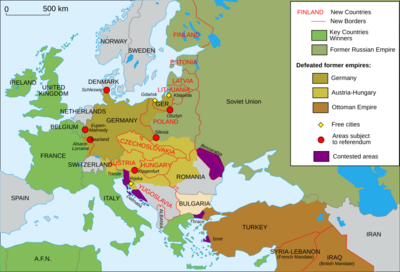
Countries that Gained or Regained Territory or Independence
 Armenia: Became independent from the Russian Empire.
Armenia: Became independent from the Russian Empire. Australia: Gained control of German New Guinea, the Bismarck Archipelago, and Nauru.
Australia: Gained control of German New Guinea, the Bismarck Archipelago, and Nauru. Austria: Gained some land from Hungary.
Austria: Gained some land from Hungary. Azerbaijan: Became independent from the Russian Empire.
Azerbaijan: Became independent from the Russian Empire. Belgium: Gained control of Eupen-Malmedy and African lands from the German Empire.
Belgium: Gained control of Eupen-Malmedy and African lands from the German Empire. Czechoslovakia: Formed from parts of the Austrian and Hungarian Empires.
Czechoslovakia: Formed from parts of the Austrian and Hungarian Empires. Danzig: Became a semi-independent free city.
Danzig: Became a semi-independent free city. Denmark: Gained Nordschleswig from the German Empire.
Denmark: Gained Nordschleswig from the German Empire. Estonia: Became independent from the Russian Empire.
Estonia: Became independent from the Russian Empire. Finland: Became independent from the Russian Empire.
Finland: Became independent from the Russian Empire. France: Gained Alsace-Lorraine and various colonies in Africa and the Middle East.
France: Gained Alsace-Lorraine and various colonies in Africa and the Middle East. Georgia: Became independent from the Russian Empire.
Georgia: Became independent from the Russian Empire. Greece: Gained Western Thrace from Bulgaria.
Greece: Gained Western Thrace from Bulgaria. Ireland: The Irish Free State gained independence from the United Kingdom.
Ireland: The Irish Free State gained independence from the United Kingdom. Italy: Gained South Tyrol, Trieste, Istria, and Zadar from Austria-Hungary.
Italy: Gained South Tyrol, Trieste, Istria, and Zadar from Austria-Hungary. Japan: Gained Jiaozhou Bay and islands in the Pacific from Germany.
Japan: Gained Jiaozhou Bay and islands in the Pacific from Germany. Latvia: Became independent from the Russian Empire.
Latvia: Became independent from the Russian Empire. Lithuania: Became independent from the Russian Empire.
Lithuania: Became independent from the Russian Empire. New Zealand: Gained control of German Samoa.
New Zealand: Gained control of German Samoa. Poland: Recreated and gained parts from the Austrian, German, Russian, and Hungarian Empires.
Poland: Recreated and gained parts from the Austrian, German, Russian, and Hungarian Empires. Portugal: Gained control of the port of Kionga.
Portugal: Gained control of the port of Kionga. Romania: Gained Transylvania, parts of Banat, and other regions from Hungary and Austria, and Bessarabia from Russia.
Romania: Gained Transylvania, parts of Banat, and other regions from Hungary and Austria, and Bessarabia from Russia. South Africa: Gained control of South West Africa.
South Africa: Gained control of South West Africa. Turkey: Gained some land from the Russian Empire, but lost territory overall.
Turkey: Gained some land from the Russian Empire, but lost territory overall. United Kingdom: Gained territories in Africa and the Middle East managed by the League of Nations.
United Kingdom: Gained territories in Africa and the Middle East managed by the League of Nations. Yugoslavia: Created from the Kingdom of Serbia and parts of Austria-Hungary.
Yugoslavia: Created from the Kingdom of Serbia and parts of Austria-Hungary.
Nations that Lost Territory or Independence
 Austria: As a successor to the Austro-Hungarian Empire.
Austria: As a successor to the Austro-Hungarian Empire. Bulgaria: Lost Western Thrace to Greece and other parts to Serbia (Yugoslavia).
Bulgaria: Lost Western Thrace to Greece and other parts to Serbia (Yugoslavia). China: Temporarily lost Jiaozhou Bay and most of Shandong to Japan.
China: Temporarily lost Jiaozhou Bay and most of Shandong to Japan. Germany: As a successor to the German Empire.
Germany: As a successor to the German Empire. Hungary: As a successor to the Austro-Hungarian Empire.
Hungary: As a successor to the Austro-Hungarian Empire. Montenegro: Joined with Serbia to become part of Yugoslavia.
Montenegro: Joined with Serbia to become part of Yugoslavia. Russian SFSR: As a successor to the Russian Empire.
Russian SFSR: As a successor to the Russian Empire. Turkey: As a successor to the Ottoman Empire, it lost much territory, though it gained some and reversed other losses.
Turkey: As a successor to the Ottoman Empire, it lost much territory, though it gained some and reversed other losses. United Kingdom: Lost most of Ireland (as the Irish Free State), Egypt in 1922, and Afghanistan in 1919.
United Kingdom: Lost most of Ireland (as the Irish Free State), Egypt in 1922, and Afghanistan in 1919.
Social Trauma: The "Lost Generation"
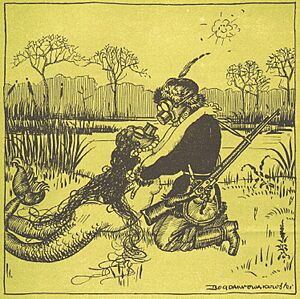
The war deeply affected people in all participating countries. The hopeful feeling of the early 1900s was gone. Those who fought became known as "the Lost Generation." They never fully recovered from their suffering. For years, many in Europe mourned. Memorials were built in thousands of towns.
So many British men died or were injured. One girls' school was told that only 10% of their students would marry. A 1921 census found 1.72 million more women than men in England and Wales. Many women remained single.
By 1923, British leaders realized a new threat. Poison gas and bombing civilians were new horrors of World War I. The British people had not feared invasion for centuries. But now, the threat of gas bombs from enemy planes created exaggerated fears of future wars. This meant Britain's old policy of balancing power in Europe no longer protected its people.
One grim fact was that more men died in battle than from disease. In most previous wars, disease was the main cause of death.
This social trauma showed itself in many ways. Some people hated nationalism because they thought it caused the war. They worked for a more international world through groups like the League of Nations. Pacifism, the belief that war is wrong, became popular. Others felt the opposite. They believed only military strength could protect them in a chaotic world.
A sense of disappointment and cynicism grew. Many believed the war marked the end of the world they knew. This included the collapse of capitalism and imperialism. Communist and socialist movements gained popularity they had never seen before. These feelings were strongest in areas hit hardest by the war, like central Europe, Russia, and France.
Artists like Otto Dix and Käthe Kollwitz showed their experiences in their art. Authors like Erich Maria Remarque wrote harsh novels about the war. These works had a strong impact. They caused controversy and showed different views of the war. In Germany, nationalists, including the Nazis, believed this art was "degenerate." They felt it harmed society and dishonored the dead.
Economic Consequences: Debt and Change
The war left Allied countries deeply in debt to the United States. Germany's economy was ruined. It could only pay reparations with loans from American banks. Many countries wanted to return to the gold standard, even though some thought it would hurt their economies.
After the war, governments didn't go back to old policies. Instead, they put in place controls on money and trade barriers. New borders also made things harder. Passport controls, which started as a temporary war measure, made it difficult for people to move for work. This stopped labor costs from evening out between rich and poor countries.
The end of the first total global war left industries with too much capacity for military production. Many companies that specialized in war-related goods went out of business. Some industries, like shipbuilding, had many orders at first to replace lost ships. But they struggled once demand returned to normal.

Remains of Ammunition: The Iron Harvest
In areas where trenches and fighting lines were, like the Champagne region of France, a lot of unexploded ordnance remains. Some of it is still dangerous. It continues to cause injuries and deaths even today. Farmers often find these old bombs and shells when plowing their fields. This is called the "iron harvest." Some of this ammunition contains toxic chemicals like mustard gas. Cleaning up major battlefields is an ongoing job. Squads remove, defuse, or destroy hundreds of tons of unexploded ammunition every year in Belgium, France, and Germany.
Memorials: Remembering the Fallen
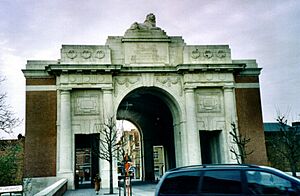
War Memorials Around the World

Many towns in the countries that fought in the war have memorials. These are dedicated to local people who died. Some examples include:
- Australian War Memorial, Canberra, Australia
- Liberty Memorial, Kansas City, Missouri, United States
- Menin Gate Memorial, Ypres, Belgium
- Vimy Ridge Memorial, Vimy, France
- Shrine of Remembrance, Melbourne, Australia
- National War Memorial, Ottawa, Ontario, Canada
Tombs of Unknown Soldiers
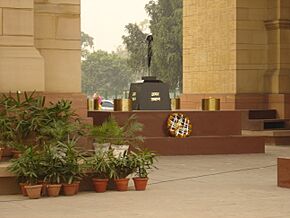
Many countries also have tombs for unknown soldiers. These honor all soldiers whose remains were never identified.
- Monument to the Unknown Hero, Belgrade, Serbia
- Amar Jawan Jyoti, New Delhi, India
- Tomb of the Unknown Soldier, Ottawa, Ontario, Canada
- Arc de Triomphe, Paris, France
- The Tomb of the Unknown Warrior in Westminster Abbey, London, United Kingdom
- Tomb of the Unknowns, Arlington National Cemetery, Virginia, United States
- Tomba del milite ignoto, Rome, Italy
See also
- Historiography of World War I
- International relations (1919–1939)
- Revolutions of 1917–1923
- Interwar period
- Political history of the world




